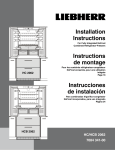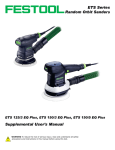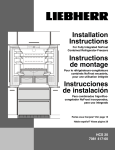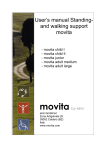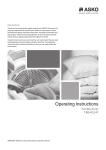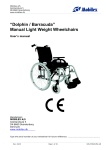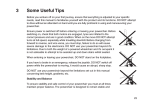Download Liebherr Refrigerator HCB 2062 User's Manual
Transcript
Installation Instructions For Fully Integrated NoFrost Combined Refrigerator-Freezers HC 2062 HCB 2062 HC/HCB 20 7083 319-00 Important PLEASE READ AND FOLLOW THESE INSTRUCTIONS TO THE INSTALLER It is very important that the guidelines and instructions are followed in the manual to ensure proper installation and operation of the unit. The Installation Guidelines section contains important information for making sure the installation is correct. Read and understand all the information in Installation Guidelines and in this manual before the unit is installed. These instructions contain Warning and Caution statements. This information is important for safe and efficient installation. Always read and follow all Warning and Caution statements! Warning indicates a potentially hazardous situation which, if not avoided, could result in death or serious injury. Always wear protective devices such as protective gloves and eye shields when installing the appliance. Also use hearing protection when drilling holes into concrete floors. Caution indicates a potentially hazardous situation which, if not avoided, may result in minor or moderate injury. Contents Page Planning Information Unit dimensions............................................... 4 Unit Venting...................................................... 4 Cabinet opening dimensions............................ 5 Panel Dimensions Framed Cabinet Design.................................... 6 Panel Dimensions Frameless Cabinet Design.............................. 7 Blocking For Safety Mounting the anti - tipping device on concrete floors................................................................ 8 Mounting the anti - tipping device on wooden floors................................................................ 8 Mounting the anti tipping device at cabinets deeper than 24"............................................... 9 Cover strips...................................................... 9 Ice Maker Safety instructions and warnings................... 10 Water connection........................................... 10 Connection to the water supply..................... 10 Installation Leveling the Refrigerator............................... 12 Adjusting the front of the drawer................... 12 Fasten the appliance in the recess................ 12 Before mounting the door panels.................. 12 Mounting the attachment brackets onto the door panels...................................... 13 Mounting the freezer drawer panels.............. 14 Mounting the refrigerator door panels....... 14-17 Mounting the ventilation grille........................ 17 IMPORTANT This highlights information that is especially relevant to a problem-free installation. Make sure incoming voltage is the same as the unit rating. To reduce the risk of fire, electric shock, or personal injury, installation work and electrical wiring must be done by a qualified electrician in accordance with all applicable codes and standards, including fire-rated construction. 2 Installation Guidelines Area Requirements Verify the following: ELECTROCUTION HAZARD Electrical grounding required. This appliance is equipped with a three-prong (grounding) polarized plug for your protection against possible shock hazards. • Do not remove the round grounding prong from the plug. • Do not use a two-prong grounding adapter. •Do not use an extension cord to connect power to the unit. • Floors can support refrigerator’s weight plus approximately 1200 pounds (544 kg) of food weight. • Finished kitchen floor height is level. Appliance must be shimmed level if the floor heights are not equal to make sure air vents are not obstructed. • Remove anything attached to rear or side walls that can obstruct appliance opening. • Cutout dimensions are accurate. To protect the appliance from possible damage, allow the appliance to stand 1/2 to 1 hour in place before turning the electricity on. This allows the refrigerant and system lubrication to reach equilibrium. • Electrical outlet is in correct location. Do not install this refrigerator-freezer next to any other refrigerator. Installing this refrigerator-freezer next to any other refrigerator or freezer can cause condensation or cause damage to the appliance. Customer’s Responsibility Electrical Requirement A 115 Volt, 60 Hz, 15 Amp fused electrical supply is required. We recommend using a dedicated circuit for this appliance to prevent electrical overload. Follow the National Electrical Code and local codes and ordinances when installing the receptacle. If codes require a separate grounding circuit to be used, have a qualified electrician install the circuit. Blocking for Safety Do not ground to a gas pipe. Check with a qualified electrician if you are not sure the appliance is properly grounded. Do not have a fuse in the neutral or grounding circuit. The anti tipping brackets must be installed to prevent the unit from tipping after it is installed. Refer to Blocking for Safety. Unit Venting Do not restrict the air flow. Air flow must be provided for the unit to operate. ELECTRIC SHOCK HAZARD • Electrically ground appliance. • Do not use an extension cord. • Failure to follow these instructions could result in fire or electric shock. 3 Planning Information Unit Dimensions Unit Venting - Figure 1 - Figure 3 HC/HCB 20 appliances do not require any ventilation openings in the cabinet. The required airflow is directed through the toe kick area. Figure 1 A = 3" (76 mm) B = 79-13/16" (2027 mm) C = 35-13/16" (910 mm) D = 3" (76 mm) E = 24" (610 mm) G = 42-7/16" (1078 mm) H = 37-1/8" (943 mm) Door swing clearence - Figure 2 Please allow for door swing clearance at locations next to a wall. The illustrated measurement is without mounted front panels. Be sure to add your panel thickness and handle depth to this measurement in order to avoid interferences. Figure 3 It is important to use the provided cover grille for the ventilation opening. This opening must not be covered with a cabinet base. Figure 2 4 Planning Information Cabinet Opening Dimensions Cabinet Height C Inset cabinet Depth B - Figure 4 Frameless/faceframe cabinet Depth B 80" 24" + panel thickness 24" 84" 24" + panel thickness 24" For appliance with panel to be flush, adjacent cabinetry depth must equal appliance depth (24") plus panel thickness (5/8" - 3/4"). IMPORTANT Do not install the shut-off valve behind the appliance. The position of the electrical outlet is possible within the grey shaded areas or above the appliance. Water line opening Water supply line Figure 4 IMPORTANT IMPORTANT For 24" cabinets, the water line opening must be in the location as shown in Figure 4. The free length of the water supply line must be at least 31-1/2" (800 mm) when the tube comes out of the prescribed opening. With cabinets deeper than 24", there is room to fit the pipe behind the appliance and the wall so there are no requirements for the water line lead out position. 5 Planning Information Panel Dimensions - Inset Installation Style - Figure 5 The panels should be at least 5/8 inch (16 mm) thick to allow the connecting rails to be fastened to them. Appliance and panels sit fully within the opening and are flush with what could be its own box, between two pantry cabinets or decorative columns, etc. This is the most common installation scenario. IMPORTANT The maximum panel thickness is 3/4" (19 mm). You can order stainless steel panels for inset installation style. Refrigerator door panels 80”- article-number 9900 337-00 Refrigerator door panels 84”- article-number 9900 335-00 Freezer drawer panels - article-number 9900 323-00 Cabinet Opening A Refrigerator door panel B 80" (2032 mm) 45 - 1/4" (1150 mm) 84" (2134 mm) 49 - 1/4" (1251 mm) Figure 5 6 Planning Information Panel Dimensions - Frameless Installation Style - Figure 6 The gap between panels with frameless installation style is 1/4" (6 mm). The panels should be at least 5/8 inch (16 mm) thick to allow the connecting rails to be fastened to them. With this installation style, these wider appliance panels partially overlay the shared side gables of adjacent cabinetry so as to mimic the look of a frameless style cabinet. IMPORTANT The maximum panel thickness is 3/4" (19 mm). Cabinet Opening C Refrigerator door panel D 80" (2032 mm) 45 - 3/4" (1162 mm) 84" (2134 mm) 49 - 3/4" (1264 mm) Figure 6 7 Blocking for Safety Mounting the anti tipping device on concrete floors - Figure 7 - 8 Secure the appliance in place so it does not tip forward when the fully stocked door is opened. The anti tipping bracket is provided with the appliance. Wall 1.Mark the center line of the appliance on the back wall. Align the anti tipping bracket center to this line. Be sure that there is no plumbing or electrical wiring located in this area which screws or drills could damage. 2.Drill a 3/8" diameter hole in any position as shown in Figure 7 using a carbide drill bit. Figure 7 Wall Plate The depth of the holes must exceed the overall length of the anchors provided. Clean the holes after drilling. Wall 3.Attach washer and screw on hex nut to the end of each anchor. Drive in all 3 anchors. Align the bracket center to the center line on the back wall again. Figure 8 Fasten the anchors by turning the hex nut. 4.Fasten bracket with 3 screws (1/4" x 2-1/8") into the wall plate (Figure 8). Wall Plate Mounting the anti tipping device on wooden floors - Figure 9 1.Mark the center line of the appliance on the back wall. Align the anti tipping bracket center to this line. Be sure that there is no plumbing or electrical wiring located in this area which screws or drills could damage. Wall 2.Fasten bracket to the wooden floor using 5 screws (1/4" x 2-1/8"). Drill pilot holes if necessary. 3.Fasten bracket with 3 screws (1/4" x 2-1/8") into the wall plate. Figure 9 Wall Plate 8 Blocking Mounting the anti tipping device in cabinets deeper than 24" - for Safety Cover strips - Figure 12 Before connection to the water supply, the cover strips provided must be fitted to the appliance. It is necessary because the appliance will be moved into its recess. Figure 10 - 11 To ensure the compressor mounting plate reaches the anti tipping bracket in cabinets deeper than 24", a wooden spacer must be mounted between the appliance back and the wall. The anti tipping bracket will be fastened to the floor downwards and to the spacer backwards. • Remove the cover band from the strips and stick them to the left and right front edge of the appliance housing (Figure 12). Be sure the wooden spacer is fastened securely to the floor. Measuring for mounting the wooden spacer on inset kitchen cabinets - Figure 10 Depth of spacer depending on clearance between appliance and wall Panel thickness Figure 10 Measuring for mounting the wooden spacer on frameless kitchen cabinets - Figure 11 Depth of spacer depending on clearance between appliance and wall Figure 12 Figure 11 IMPORTANT If the floor slopes down sideways, the antitipping bracket must be fitted horizontally. Lay down spacers in the appropriate positions. 9 IceMaker IceMaker • The solenoid valve has a metric R3/4 male connector. A R3/4 (metric) to a 1/4" OD adapter is supplied with the ice maker. The icemaker for the combined refrigerator-freezer is located in the freezer compartment. These instructions only refer to the installation of the icemaker. Please refer to the Use and Care Manual provided with the appliance for operation instructions. The combined refrigerator-freezer must be level for the icemaker to function properly. • Insert the water strainer provided into the OD adapter with the cavity downwards. Safety Instructions and Warnings IMPORTANT Be sure the strainer is inserted with the cavity downwards. Otherwise the strainer could be damaged when mounting the OD adapter onto the solenoid valve. • Do not install the water connection while the combined refrigerator-freezer is connected to an electrical outlet. • The connection to the water supply may only be made by a trained and licensed plumber. • The water quality must comply with the drinking water regulations for the geographical area where the appliance is located. • All equipment and devices used to supply the water to the appliance must comply with the current regulations for your geographical area. Connection to the Water Supply 1. Move the appliance towards the final position and leave enough space to work behind. 2. Insert the water supply line into it's intended opening at the back of the appliance (Figure 14). Water Connection • The water supply pressure requirements are different based on whether or not the supplied Liebherr water filter is installed. With the filter installed, the pressure must be in the range of 40-90 psi (2.8-6.2 bar). Without the filter installed the acceptable pressure range is 22-87 psi (1.5-6 bar). Failure to meet these requirements will likely result in ice maker malfunction and possibly cause a water leakage that can damage flooring and surrounding furniture. Figure 14 3. Move the power supply line to the area of the electrical outlet. • Use a 1/4" OD copper line to connect the water supply to the solenoid valve. This is not supplied with the refrigerator (Figure 13). Do not connect to the electrical outlet before the installation is completed and the water line is connected to the solenoid valve. • A shut-off valve, such as the saddle valve illustrated here, must Figure 13 be installed between the hose line and the main water supply so the water supply can be stopped if necessary. Do not install the shut-off valve behind the refrigeration unit. 10 IceMaker 4. Push the appliance slowly to the back wall until the compressor mounting plate makes contact with the anti-tipping bracket (Figure 15). To prevent the appliance from tipping forward the compressor mounting plate must have contact with the anti tipping bracket (Figure 15). Wall Figure 16 Appliance Anti - tipping bracket Compressor mounting plate Figure 15 Figure 17 5. Remove the cover from the valve connector (Figure 16). 9. Open the shut-off valve for the water supply and check the entire water system for leaks. 6. The water line is visible at the front of the aplliance. Connect the water line with the OD adapter (Figure 16). IMPORTANT After starting up the appliance, the water pipe system must be purged of any air. Refer to chapter "Bleeding the ice maker" in the operating instructions. 7. Bleed the air from the water line by opening the water supply temporarily. 8. Screw the OD adapter onto the solenoid valve (Figure 17). 11 Installation Leveling the Appliance 1. Adjust the height of the appliance at the front by twisting the leveling feet (A/F 27). Use the open-ended spanner provided. 2. Adjust the height of the appliance at the rear by turning the . adjusting bolts 3. Rotate leveling feet until firmly in place against the floor. Fasten the appliance in the recess - Figure 20 - Figure 18 Fasten the appliance in the recess through the upper and lower hinges of the refrigerator doors. Use 2 screws for each hinge. 1 2 1 Figure 18 screws (4 x 16 mm) To prevent the appliance from tipping (Figure 19) forward the leveling feet must have contact with the floor. 1 Figure 20 Before mounting the door panels Adjusting the front of the drawer - Figure 21 Remove cover and unscrew the upper of both refrigerator attachment bracket doors. These brackets will be mounted onto the refrigerator door panels. - Figure 19 1 2 If required, the front of the freezer drawers can be adjusted. Transfer the screws shown in the illustration (on the left and right sides of the freezer drawer) individually to the long slots below. Tighten the screws in the front of the drawer once it is in the right position. iMPORTANT The nuts are needed to fit the premounted panels onto the refrigerator doors. Side view of the freezer drawer pulled out Figure 21 Figure 19 12 Installation Mounting the attachment brackets onto the door panels - Figure 22 Mark lines on the refrigerator door panels as shown in Figure 22. Align the dismounted brackets of the refrigerator doors to the lines on the refrigerator door panels as shown in Figure 22 a. Fasten each bracket with any hole wherever possible using a minimum of 6 screws 4 x 16 mm. Fasten the brackets provided onto the freezer drawer panels using three screws (4 x 16 mm) for each bracket (Figure 22 b). Refrigerator door panels Figure 22 a Freezer drawer panel Freezer drawer panel Figure 22 Figure 22 b 13 Installation Mounting the freezer drawer panels - Figure 23 Mounting the refrigerator door panels - Figures 24 - 33 1. Pull out the upper freezer drawer and screw on the panel with three screws at left and right hand side using the screws as shown in Figure 23. The description is for one panel only. The procedure is the same for both panels. 1. Open the refrigerator door and hang the panel on the adjusting bolts (Figure 24). 2. Close the drawer and check the position to the surrounding cabinet panels. Align the panel in vertical direction by loosening the screws left and right. Finally tighten the screws. 2. Screw on the hex nuts to the adjusting bolts and finger tighten temporarily (Figure 24). Do not overtighten. Do not use a power driver. 3.Pull out the lower freezer drawer and fasten the lower panel in the same way. 4. Finally cover the gap between the drawer and the panel of both freezer drawers with the strips provided. Remove the foil from the adhesive surface of the strip and stick on the top of the appliance drawer (Figure 23) making sure the flexible gasket is fully inserted in the gap. Figure 24 3. Close the door and check the height of the panel. 4. Align the panel in its vertical position if necessary. Loosen the hex nuts and turn the adusting bolts using a screwdriver for slotted screws (Figure 25). Screw 3.5 x 13 mm Figure 23 Figure 25 14 Installation To make it possible to fasten the refrigerator panel at the bottom the soft-stop cylinder must be dismantled. 7. Dismantle the lower attachment bracket from the refrigerator door. Align the bracket to the lines on the refrigerator door panel. (Figure 28). 5. Grasp the soft-stop cylinder and pull down (Figure 26). Fasten the bracket with any hole wherever possible using a minimum of 6 screws 4 x 16 mm. The soft-stop cylinder retracts in the detached state. Figure 28 8. Open the refrigerator door and hang the panel on the adjusting bolts (Figure 29). Figure 26 9. Screw on the hex nuts to the adjusting bolts and finger tighten temporarily (Figure 29). 6. Transfer the lower edge of the attachment bracket onto the panel using a pencil. (Figure 27). Remove the panel from the refrigerator door. Figure 29 Figure 27 15 Installation 10.Move the panel to the left until it makes contact with the center rail (Figure 30). 13.Extend the soft-stop cylinder and connect with the ball stud (Figure 32). 11.Tighten the hex nuts finally. Figure 32 Figure 30 14.Click cover into place (Figure 33). 12.Fasten the refrigerator panel using the same screws that held the lower bracket before removal (Figure 31). Figure 33 Figure 31 16 Installation Mounting the ventilation grille - Figure 34, 35 1. Pull out the bottom freezer drawer. 2. Remove the blue protection film from the dust filter provided and insert the filter into its opening in the toe kick area as shown in Figure 34. Attach the filter at the bottom, press down the button and click into place. Figure 34 3. Mount the ventilation grille as shown in Figure 35. IMPORTANT Only use the ventilation grille provided with the appliance. This grille is required for proper operation of the appliance. The ventilation opening must not be covered with a cabinet base. Failure to use the supplied grille can result in product failure and will void the warranty. Figure 35 17

















